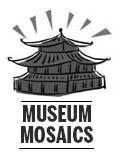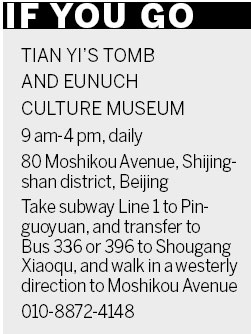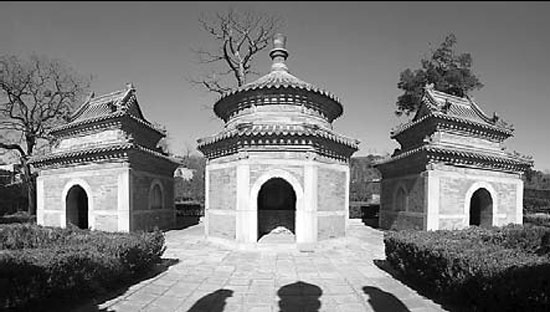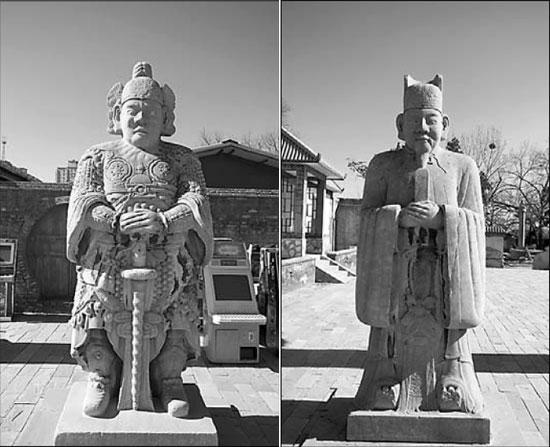One man's loss is another's gain
Updated: 2012-11-04 07:25
By Brian Salter(China Daily)
|
|||||||||
|
The Eunuch Culture Museum is located in the premises of the tomb of Tian Yi, a famous eunuch of the Ming Dynasty. Photos by Brian Salter / China Daily |
|
The three pavilions in the middle section of Tian Yi's tomb. |
The Eunuch Culture Museum is not well known, reports Brian Salter, but even so it is one of the capital's most fascinating museums.
One of the greatest pleasures in China's capital is the more than 130 museums, ranging from the well-known and crowded Palace Museum to the less well-known and relatively empty Watermelon or Goldfish museums.
One museum that surely deserves to be better known is situated in the far west of the city, not far from the last stop on Line 1 at Pinguoyuan. What makes it particularly interesting is that it is the only one of its kind in the world.
Even so, I gather that visitors are so rare that even with its 8 yuan ($1.30) entrance fee, the museum doesn't make enough to cover its electricity bill. I'm talking of a museum devoted to the history and achievements of eunuchs.
Eunuchs have existed in civilizations across the world, but it is China where they held the greatest significance.
In ancient China, castration was both a punishment and a way to work for the emperor. Because eunuchs were unable to have children it was thought they would not be tempted to seize power.

Toward the end of the Ming Dynasty (1368-1644), there were some 70,000 of them employed by the emperor. China's "last eunuch", Sun Yaoting, served China's last emperor, Puyi, and was 93 when he died in 1996 at his home in Beijing.
The Eunuch Culture Museum is located in the premises of the tomb of Tian Yi, a famous eunuch who lived from 1534 to 1605.
During the wartime before the founding of New China, warlords ransacked Tian Yi's tomb. The overall structure of the tomb has been well preserved and in the 1950s, the mausoleum yard was turned into a kindergarten.
To protect the children's safety, the back entrance of the mausoleum was sealed off and no one was allowed to enter, thereby protecting it from further damage.
Items now on display mainly consist of articles left behind by Sun, including a yellow jacket given to him by Puyi.
The cemetery occupies 6,000 square meters and contains five tombs of Tian Yi and four other eunuchs standing to the left and right of Tian's tomb.
On either side of the entrance is a 3-meter tall statue of Tian - one dressed as a warrior and the other a scholar.
Moving to the middle section, there are three pavilions, each of which has a stone tablet recording Tian's achievements. The pavilion in the middle stands out from the other two, having a round shaped dome and lion motifs, reflecting a mix of East and West.

Behind the pavilions is Shouyu Gate, once believed to be the dividing line between this world and the netherworld. It is in this area that one finds the carved marble tomb mounds of Tian and his four fellow eunuchs.
You can even go down some steps to visit the crypt of Tian. It's pretty dark down there, and you feel pretty grateful for a banister rail to hang onto for dear life as you descend the steps. Even with the very low wattage light bulbs they have installed, you find yourself stumbling forward with your hands stretched out feeling for a wall that may or may not be there.
Close to the entrance of the cemetery, hidden away down a side passage, is the actual museum - five rooms, all bristling with all the information you might care to learn about the life and times of eunuchs, including a display illustrating the castration process, a preserved mummy, ancient sex toys, and even a photo of a castrated boy.
In one glass case is the chair and walking stick of Sun Yaoting. Another glass case displays a wood model of a ship captained by Zheng He - the famous 15th century explorer who was castrated at the age of 11.
Cai Lun, the 1st century inventor of paper, was also a eunuch, as was Li Lianying who persuaded Empress Dowager Cixi (1835-1908) to divert funds meant for modernizing China's navy to build the Summer Palace.
No doubt today's tourists are pretty thankful that he did. But when they dug up Li Lianying's grave, his head was missing. Whether he was buried without his head or whether those who hated him removed it, we'll probably never know.
Contact the writer at sundayed@chinadaily.com.cn.
|
On either side of the entrance is a 3-meter tall statue of Tian Yi - one dressed as a warrior and the other, a scholar. |
(China Daily 11/04/2012 page15)


